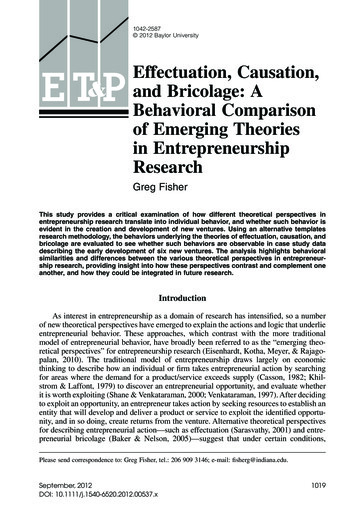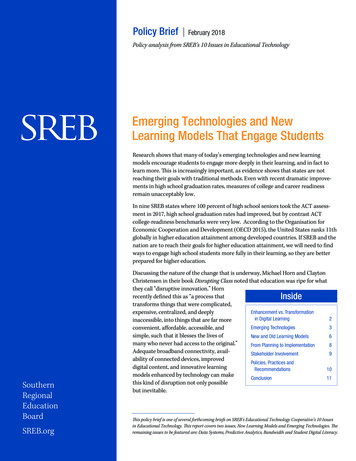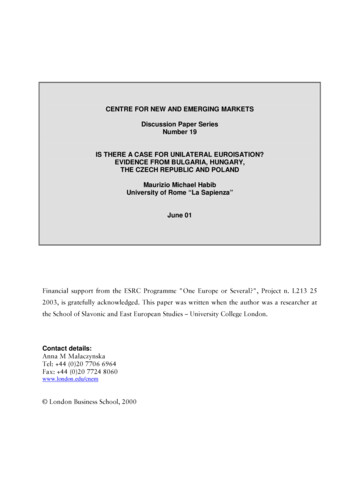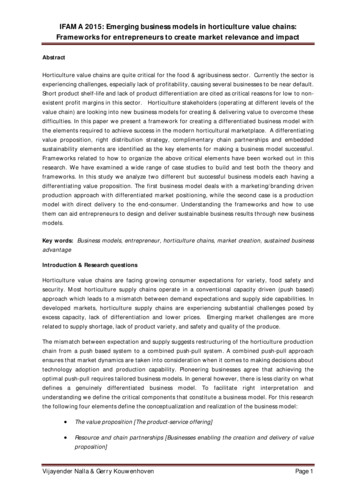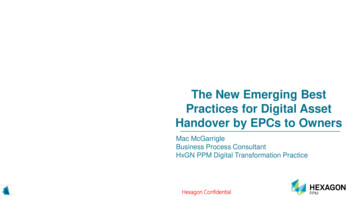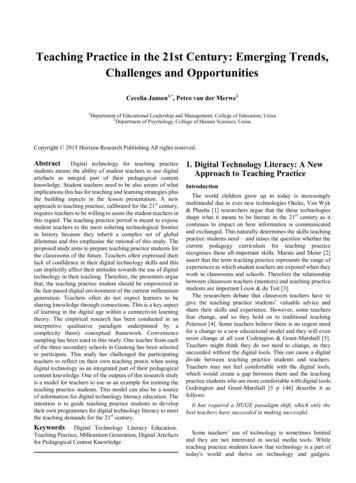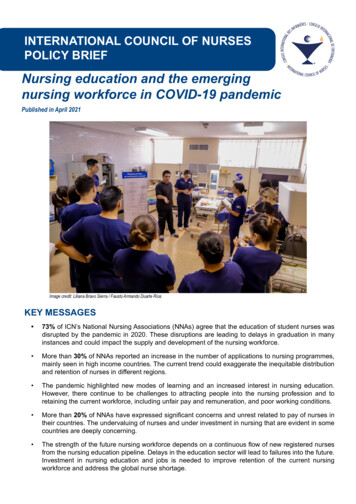
Transcription
INTERNATIONAL COUNCIL OF NURSESPOLICY BRIEFNursing education and the emergingnursing workforce in COVID-19 pandemicPublished in April 2021Image credit: Liliana Bravo Sierra / Fausto Armando Duarte RíosKEY MESSAGES 73% of ICN’s National Nursing Associations (NNAs) agree that the education of student nurses wasdisrupted by the pandemic in 2020. These disruptions are leading to delays in graduation in manyinstances and could impact the supply and development of the nursing workforce. More than 30% of NNAs reported an increase in the number of applications to nursing programmes,mainly seen in high income countries. The current trend could exaggerate the inequitable distributionand retention of nurses in different regions. The pandemic highlighted new modes of learning and an increased interest in nursing education.However, there continue to be challenges to attracting people into the nursing profession and toretaining the current workforce, including unfair pay and remuneration, and poor working conditions. More than 20% of NNAs have expressed significant concerns and unrest related to pay of nurses intheir countries. The undervaluing of nurses and under investment in nursing that are evident in somecountries are deeply concerning. The strength of the future nursing workforce depends on a continuous flow of new registered nursesfrom the nursing education pipeline. Delays in the education sector will lead to failures into the future.Investment in nursing education and jobs is needed to improve retention of the current nursingworkforce and address the global nurse shortage.
INTERNATIONAL COUNCIL OF NURSESBACKGROUNDThe COVID-19 pandemic has disrupted educationsystems around the world and nursing educationwas no exception. The extent of disruption varieswidely from country to country. Countries that wereparticularly affected by COVID-19 report higherdegrees of disruption to their nurses’ education. InDecember 2020, ICN undertook an online survey ofmore than 130 associations: 64 responses from NNArepresentatives of all World Health Organizationregions were received, with a response rate of 49%.At the beginning of the pandemic, many organisationshalted nursing students’ clinical placements to helpconserve dwindling personal protective equipment(PPE) and to limit their involvement in direct patientcare. To reduce the spread of the virus, mostcountries closed physical education institutions, atleast temporarily, and some remain closed to thisday. Nursing students are facing obstacles to thecompletion of their required clinical education hours,which is leading to delays in them being able tograduate. Nurse educators have expressed worriesabout the negative impacts that such delays andmodifications may have on the learning trajectory ofnursing students. Nurses across the globe have alsoraised concerns over the unprecedented challengesthey face in acquiring continuing professionaldevelopment (CPD) and how this may jeopardisetheir ability to keep their practice up to date, advancetheir nursing knowledge and develop their careers.Despite innovative approaches to nursing education,including the use of new technologies to allowdistance learning, these disruptions risk delayingor restricting the nursing workforce supply, which,on top of the predicted shortages resulting from theCOVID-19 Effect, could further exacerbate existingworkforce shortages.Based on information from reports submitted byICN’s NNAs and recent ICN surveys, this policy briefgives an overview of the disruption and adaptationsin nursing education during the COVID-19 pandemic.It highlights the impacts of this disruption on thenursing workforce supply, and explores ways toretain the existing nursing workforce and attract anew generation of nurses into the profession.DISRUPTION TO NURSING EDUCATION DURING THE PANDEMICOf those surveyed, 73% of National NursesAssociations (NNA) report that undergraduatenursing education has been disrupted, and54% reported disruption to post registration/postgraduate education. Several extremelychallenging factors contributed to the disruptionof nursing education during the pandemic. An ICNsurvey in August 2020 found that about a third ofthe NNAs surveyed reported moderate to severeshortages of PPE, particularly in long-term-carefacilities in some countries.1 High rates of infectionand death among nurses were recorded in manycountries. The nursing workforce was stretched tocapacity, with high workloads and long working hoursmaking mentoring and preceptorship challenging.As COVID-19 cases rose in patient and nursepopulations, threats to both the health and wellbeing,and the learning experiences of nursing studentsincreased. Many academic institutions made thedifficult decision to delay or cancel their students’clinical placements.Disruption of clinical placement may affectquality of education and delay graduationAdequate exposure to clinical settings is already achallenge in nursing education. ICN’s survey of NNAsshowed that 46% of countries experienced delaysor cancellations to nursing students’ clinicalplacements. Another 41% of countries reportedthat placements were restricted to certain areas.Settings where clinical placements were cancelledentirely were those that were managing COVID-19patients, elective surgery, non-urgent procedures,and primary care settings (for Advanced PracticeNurses). Instead of providing direct patient care,clinical placements were replaced by participating inskills laboratory experiences, and students lost theopportunity to have exposure to working in theseclinical areas. In some countries, it was reportedthat postgraduate education for nurses had beensuspended to enable the nurses involved to resumework within healthcare facilities.These disruptions have the potential to affect thequality of nursing education and place increasedstress on students and clinical areas.2
INTERNATIONAL COUNCIL OF NURSES57% of countries report delays in studentgraduation, including 7% that reported majordelays of 12 months or more. Nursing studentsexpressed concerns and anxiety about delays incompleting their nursing programmes and the effectthey would have on them achieving their careergoals as Registered Nurses. Some NNAs receivedinquiries from nursing students about their abilityto graduate within the standard time frame. In astudy conducted across five institutions in Belgium,students expressed frustration that, despite receivingfewer learning opportunities due to clinical placementdisruptions or overburdened preceptors, they wereexpected to meet the same learning objectives.2Disruptions could impact the nursing workforcequality and supplyICN is concerned that more than half of NNAs(in 32 countries) reported nursing students willexperience delays in their studies of more than sixmonths. The prolonged disruption in pre-registrationnursing education could negatively impact the flowof new nurse graduates becoming available tohealth services. Limited education resources couldlead to new admissions into nursing programmesalso experiencing delays. With some countriesexperiencing second or third waves of infections,and the rapid rise in the number of COVID-19 casesglobally, the pandemic is far from under control. Thenegative impacts on nursing education are likely tolast and the delays will continue. The disruption topostgraduate education is likely to result in a reducednumber of Advanced Practice Nurses graduating,thereby limiting access to care for some patients. Inaddition, there will be disruptions to nursing research,delaying the advancement of knowledge in all areasrelated to nursing care. The disruption to the nursingstudent pipeline will further hamper countries’ effortsin scaling up the nursing workforce in response toCOVID-19 and its aftermath. In addition, disruptionsin the usual supply of the nursing workforce couldimpose a significant global risk and have seriousimplications for health systems in some countries.CHANGES AND CHALLENGESAs nurses have shown their willingness and flexibilityto adapt to new ways of working, nursing studentsand nursing educators have embraced new ways oflearning and of delivering education. In an attemptto continue to educate nurses, many educationproviders had to quickly pivot to online learning,and some were able to provide simulated clinicalplacements. The work of nurses, highlighted duringthe pandemic, has raised the profile of the profession,changed public attitudes, and increased interest innursing as a career, but almost exclusively in highincome countries.New modes of learningICN’s survey found that 57% of NNAs report apositive effect of the pandemic on the educationsector. The biggest gains have occurred in onlinelearning. The adoption of e-learning, previouslyconsidered an alternate mode of learning, has beenrapidly accelerated.3 Face-to-face teaching wasswitched to online learning using different virtualplatforms and, in some countries, clinical simulationwas used which, with adequate resources, enhancesclinical learning. These adaptations in learningmodalities have several positive outcomes, includingincreased flexibility, student-centered learning andeasier access to learning. They offer the potential toenhance the diversity of students and increase theattractiveness of nursing programmes. It should benoted that in some instances, these changes had anegative effect on students’ ability to learn becauseof issues of access to the internet, data allowancesand lack of at-home resources.4Considering that several NNAs reported detrimentaleffects on CPD provision, the rapid increase ineducation offered online presents an opportunityto increase access and address the sustainabilityof continuing nursing education for continuingprofessional development. It also providesopportunities to bridge gaps in knowledge as nursingknowledge advances rapidly.5 One example is ICN’spartnership with the World Continuing EducationAlliance, which facilitated access to continuingnursing training in the pandemic by launching afree online platform and mobile app in a number oflow-income countries, providing various courses,including COVID-19 resources.An increased interest in nursing educationThe critical importance and resilience of nurses werebrought into focus by the pandemic, and they arenow more widely recognised as the key for change inhealth systems. More than 30% of NNAs reportedan increase in the number of applications tonurse training programmes. Recent data published3
INTERNATIONAL COUNCIL OF NURSESby the University and College Admissions Service(UCAS) in the UK, showed that more than 60,000people had applied to a nursing course for autumn2021, an increase of 32% compared to 2020.6 Asimilar trend has been noted in Norway, with a 6%increase of applicants who put nursing bachelorprogramme as their first choice in 2020.7 The interestin nurse education shows increased recognition ofthe nursing profession during the pandemic, whichis inspiring people to become a nurse. To translatethe increased interest in nursing education into astrengthened nursing workforce, countries will needto ensure a comparative increase in resources forprogramme capacity, including the numbers ofqualified faculty/lecturers, infrastructure and properlysupervised clinical placements.Of those NNA countries with an increase in the numberof applications, 71% are high income countriesand close to half are in European region. Overall,the pandemic does not appear to have reduced thenumber of student applications, but 53% of NNAsreported no increase in applications. The lackof interest in joining the nursing workforce is oftenlinked to adequacy of pay, safety concerns and poorworking conditions in some countries. It is also highlylikely related to the limited resources and the lack ofvaccine access in some countries, which can imposesome ethical challenges for nurses’ work. The Stateof the World’s Nursing report shows that nursingshortages are concentrated in low- and lower middleincome countries in the African, South-East Asia andEastern Mediterranean regions8. On top of existingdisruptions in nursing education, the current trendcould exaggerate the inequitable distribution andretention of nurses in different meThe growth in the number of Registered Nurseseach year has not been able to keep up with globaldemand and prior to the pandemic, the world wasalready facing a shortage of six million nurses.9 Asthe pandemic continues to put immense strainson health systems, some countries are reportingstrategies to bolster their nursing workforce, includingfast-tracking nursing students to graduation.10Of the NNAs surveyed, 7% reported that theirundergraduate programs have been fast-tracked.ICN is concerned that the fine balance betweenworkforce expansion and maintaining a high-qualitynursing workforce that ensures patient safety shouldcontinue to be closely monitored.Nursing students supplementing current nursingworkforce to deliver health care servicesIn response to increased demand placed onhealthcare services during the pandemic, in somecountries nursing students are being asked to optin to extended placements11. For example, in onecountry, nursing students are volunteering to supportCOVID-19 vaccination rollout efforts12. Undertakingextended placements in the clinical environment canprovide nursing students with clinical exposure to helpmeet their learning needs. However, caution shouldbe taken because of the possible risks associatedwith students undertaking clinical work, such as therisk of exposure to COVID-19 and the psychologicalimpact of certain distressing clinical situations.Entering the practice environment to support theCOVID-19 response should be optional for studentsand, importantly, their decisions need to be wellsupported by education institutions. For studentswho decide to undertake the extended placements,measures should be in place to ensure their physicalsafety and to reinforce
disruptions in nursing education, the current trend could exaggerate the inequitable distribution and retention of nurses in different regions. Fast-tracking nursing education in some countries The growth in the number of Registered Nurses each year has not been able to keep up with global demand and prior to the pandemic, the world was


